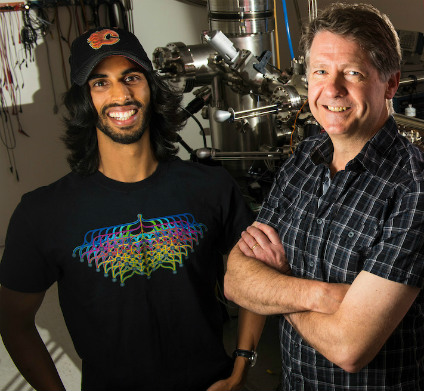Lori Ewing (Canadian Press) in an August 3, 2018 article on the Canadian Broadcasting Corporation news website, heralds a new technology intended for the 2020 Olympics in Tokyo (Japan) but being tested now for the 2018 North American, Central American and Caribbean Athletics Association (NACAC) Track & Field Championships, known as Toronto 2018: Track & Field in the 6ix (Aug. 10-12, 2018) competition.
It’s described as a ‘computerized pill’ that will allow athletes to regulate their body temperature during competition or training workouts, from the August 3, 2018 article,
“We can take someone like Evan [Dunfee, a race walker], have him swallow the little pill, do a full four-hour workout, and then come back and download the whole thing, so we get from data core temperature every 30 seconds through that whole workout,” said Trent Stellingwerff, a sport scientist who works with Canada’s Olympic athletes.
“The two biggest factors of core temperature are obviously the outdoor humidex, heat and humidity, but also exercise intensity.”
Bluetooth technology allows Stellingwerff to gather immediate data with a handheld device — think a tricorder in “Star Trek.” The ingestible device also stores measurements for up to 16 hours when away from the monitor which can be wirelessly transmitted when back in range.
…
“That pill is going to change the way that we understand how the body responds to heat, because we just get so much information that wasn’t possible before,” Dunfee said. “Swallow a pill, after the race or after the training session, Trent will come up, and just hold the phone [emphasis mine] to your stomach and download all the information. It’s pretty crazy.”
First off, it’s probably not a pill or tablet but a gelcap and it sounds like the device is a wireless biosensor. As Ewing notes, the device collects data and transmits it.
Here’s how the French company, BodyCap, supplying the technology describes their product, from the company’s e-Celsius Performance webpage, (assuming this is the product being used),
Continuous core body temperature measurement
Main applications are:
Risk reduction for people in extreme situations, such as elite athletes. During exercise in a hot environment, thermal stress is amplified by the external temperature and the environment’s humidity. The saturation of the body’s thermoregulation mechanism can quickly cause hyperthermia to levels that may cause nausea, fainting or death.
Performance optimisation for elite athletes.This ingestible pill leaves the user fully mobile. The device keeps a continuous record of temperature during training session, competition and during the recovery phase. The data can then be used to correlate thermoregulation with performances. This enable the development of customised training protocols for each athlete.
e-Celsius Performance® can be used for all sports, including water sports. Its application is best suited to sports that are physically intensive like football, rugby, cycling, long distance running, tennis or those that take place in environments with extreme temperature conditions, like diving or skiing.
…
e-Celsius Performance®, is a miniaturised ingestible electronic pill that wirelessly transmits a continuous measurement of gastrointestinal temperature. [emphasis mine]
The data are stored on a monitor called e-Viewer Performance®. This device [emphases mine] shows alerts if the measurement is outside the desired range. The activation box is used to turn the pill on from standby mode and connect the e-Celsius Performance pill with the monitor for data collection in either real time or by recovery from the internal memory of e-Celsius Performance®. Each monitor can be used with up to three pills at once to enable extended use.
The monitor’s interface allows the user to download data to a PC/ Mac for storage. The pill is safe, non-invasive and easy to use, leaving the gastric system after one or two days, [emphasis mine] depending on individual transit time.
I found Dunfee’s description mildly confusing but that can be traced to his mention of wireless transmission to a phone. Ewing describes a handheld device which is consistent with the company’s product description. There is no mention of the potential for hacking but I would hope Athletics Canada and BodyCap are keeping up with current concerns over hacking and interference (e.g., Facebook/Cambridge Analytica, Russians and the 2016 US election, Roberto Rocha’s Aug. 3, 2018 article for CBC titled: Data sheds light on how Russian Twitter trolls targeted Canadians, etc.).
Moving on, this type of technology was first featured here in a February 11, 2014 posting (scroll down to the gif where an electronic circuit dissolves in water) and again in a November 23, 2015 posting about wearable and ingestible technologies but this is the first real life application I’ve seen for it.
Coincidentally, an August 2, 2018 Frontiers [Publishing] news release on EurekAlert announced this piece of research (published in June 2018) questioning whether we need this much data and whether these devices work as promoted,
Wearable [and, in the future, ingestible?] devices are increasingly bought to track and measure health and sports performance: [emphasis mine] from the number of steps walked each day to a person’s metabolic efficiency, from the quality of brain function to the quantity of oxygen inhaled while asleep. But the truth is we know very little about how well these sensors and machines work [emphasis mine]– let alone whether they deliver useful information, according to a new review published in Frontiers in Physiology.
“Despite the fact that we live in an era of ‘big data,’ we know surprisingly little about the suitability or effectiveness of these devices,” says lead author Dr Jonathan Peake of the School of Biomedical Sciences and Institute of Health and Biomedical Innovation at the Queensland University of Technology in Australia. “Only five percent of these devices have been formally validated.”
The authors reviewed information on devices used both by everyday people desiring to keep track of their physical and psychological health and by athletes training to achieve certain performance levels. [emphases mine] The devices — ranging from so-called wrist trackers to smart garments and body sensors [emphasis mine] designed to track our body’s vital signs and responses to stress and environmental influences — fall into six categories:
- devices for monitoring hydration status and metabolism
- devices, garments and mobile applications for monitoring physical and psychological stress
- wearable devices that provide physical biofeedback (e.g., muscle stimulation, haptic feedback)
- devices that provide cognitive feedback and training
- devices and applications for monitoring and promoting sleep
- devices and applications for evaluating concussion
The authors investigated key issues, such as: what the technology claims to do; whether the technology has been independently validated against some recognized standards; whether the technology is reliable and what, if any, calibration is needed; and finally, whether the item is commercially available or still under development.
The authors say that technology developed for research purposes generally seems to be more credible than devices created purely for commercial reasons.
“What is critical to understand here is that while most of these technologies are not labeled as ‘medical devices’ per se, their very existence, let alone the accompanying marketing, conveys a sensibility that they can be used to measure a standard of health,” says Peake. “There are ethical issues with this assumption that need to be addressed.” [emphases mine]
For example, self-diagnosis based on self-gathered data could be inconsistent with clinical analysis based on a medical professional’s assessment. And just as body mass index charts of the past really only provided general guidelines and didn’t take into account a person’s genetic predisposition or athletic build, today’s technology is similarly limited.
The authors are particularly concerned about those technologies that seek to confirm or correlate whether someone has sustained or recovered from a concussion, whether from sports or military service.
“We have to be very careful here because there is so much variability,” says Peake. “The technology could be quite useful, but it can’t and should never replace assessment by a trained medical professional.”
Speaking generally again now, Peake says it is important to establish whether using wearable devices affects people’s knowledge and attitude about their own health and whether paying such close attention to our bodies could in fact create a harmful obsession with personal health, either for individuals using the devices, or for family members. Still, self-monitoring may reveal undiagnosed health problems, said Peake, although population data is more likely to point to false positives.
“What we do know is that we need to start studying these devices and the trends they are creating,” says Peake. “This is a booming industry.”
In fact, a March 2018 study by P&S Market Research indicates the wearable market is expected to generate $48.2 billion in revenue by 2023. That’s a mere five years into the future.”
The authors highlight a number of areas for investigation in order to develop reasonable consumer policies around this growing industry. These include how rigorously the device/technology has been evaluated and the strength of evidence that the device/technology actually produces the desired outcomes.
“And I’ll add a final question: Is wearing a device that continuously tracks your body’s actions, your brain activity, and your metabolic function — then wirelessly transmits that data to either a cloud-based databank or some other storage — safe, for users? Will it help us improve our health?” asked Peake. “We need to ask these questions and research the answers.”
The authors were not examining ingestible biosensors nor were they examining any issues related to data about core temperatures but it would seem that some of the same issues could apply especially if and when this technology is brought to the consumer market.
Here’s a link to the and a citation for the paper,
Critical Review of Consumer Wearables, Mobile Applications, and Equipment for Providing Biofeedback, Monitoring Stress, and Sleep in Physically Active Populations by Jonathan M. Peake, Graham Kerr, and John P. Sullivan. Front. Physiol., 28 June 2018 | https://doi.org/10.3389/fphys.2018.00743
This paper is open access.


